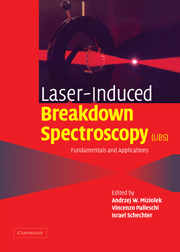Book contents
- Frontmatter
- Contents
- List of contributors
- Preface
- 1 History and fundamentals of LIBS
- 2 Plasma morphology
- 3 From sample to signal in laser-induced breakdown spectroscopy: a complex route to quantitative analysis
- 4 Laser-induced breakdown in gases: experiments and simulation
- 5 Analysis of aerosols by LIBS
- 6 Chemical imaging of surfaces using LIBS
- 7 Biomedical applications of LIBS
- 8 LIBS for the analysis of pharmaceutical materials
- 9 Cultural heritage applications of LIBS
- 10 Civilian and military environmental contamination studies using LIBS
- 11 Industrial applications of LIBS
- 12 Resonance-enhanced LIBS
- 13 Short-pulse LIBS: fundamentals and applications
- 14 High-speed, high-resolution LIBS using diode-pumped solid-state lasers
- 15 Laser-induced breakdown spectroscopy using sequential laser pulses
- 16 Micro LIBS technique
- 17 New spectral detectors for LIBS
- 18 Spark-induced breakdown spectroscopy: a description of an electrically generated LIBS-like process for elemental analysis of airborne particulates and solid samples
- Index
- References
1 - History and fundamentals of LIBS
Published online by Cambridge University Press: 08 August 2009
- Frontmatter
- Contents
- List of contributors
- Preface
- 1 History and fundamentals of LIBS
- 2 Plasma morphology
- 3 From sample to signal in laser-induced breakdown spectroscopy: a complex route to quantitative analysis
- 4 Laser-induced breakdown in gases: experiments and simulation
- 5 Analysis of aerosols by LIBS
- 6 Chemical imaging of surfaces using LIBS
- 7 Biomedical applications of LIBS
- 8 LIBS for the analysis of pharmaceutical materials
- 9 Cultural heritage applications of LIBS
- 10 Civilian and military environmental contamination studies using LIBS
- 11 Industrial applications of LIBS
- 12 Resonance-enhanced LIBS
- 13 Short-pulse LIBS: fundamentals and applications
- 14 High-speed, high-resolution LIBS using diode-pumped solid-state lasers
- 15 Laser-induced breakdown spectroscopy using sequential laser pulses
- 16 Micro LIBS technique
- 17 New spectral detectors for LIBS
- 18 Spark-induced breakdown spectroscopy: a description of an electrically generated LIBS-like process for elemental analysis of airborne particulates and solid samples
- Index
- References
Summary
Introduction
Laser-induced breakdown spectroscopy (LIBS) is a method of atomic emission spectroscopy (AES) that uses a laser-generated plasma as the hot vaporization, atomization, and excitation source. Because the plasma is formed by focused optical radiation, the method has many advantages over conventional AES techniques that use an adjacent physical device (e.g. electrodes, coils) to form the vaporization/excitation source. Foremost of these is the ability to interrogate samples in situ and remotely without any preparation. In its basic form, a LIBS measurement is carried out by forming a laser plasma on or in the sample and then collecting and spectrally analyzing the plasma light. Qualitative and quantitative analyses are carried out by monitoring emission line positions and intensities. Although the LIBS method has been in existence for 40 years, prior to 1980, interest in it centered mainly on the basic physics of plasma formation. Since then the analytical capabilities have become more evident. A few instruments based on LIBS have been developed but have not found widespread use. Recently, however, there has been renewed interest in the method for a wide range of applications. This has mainly been the result of significant technological developments in the components (lasers, spectrographs, detectors) used in LIBS instruments as well as emerging needs to perform measurements under conditions not feasible with conventional analytical techniques. A review of LIBS literature shows that the method has a detection sensitivity for many elements that is comparable to or exceeds that characteristic of other field-deployable methods.
Information
- Type
- Chapter
- Information
- Laser Induced Breakdown Spectroscopy , pp. 1 - 39Publisher: Cambridge University PressPrint publication year: 2006
References
Accessibility standard: Unknown
Why this information is here
This section outlines the accessibility features of this content - including support for screen readers, full keyboard navigation and high-contrast display options. This may not be relevant for you.Accessibility Information
- 6
- Cited by
